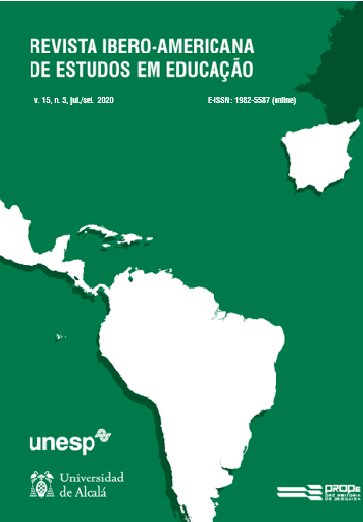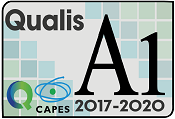Habilidades de leitura e competências de compreensão de texto de estudantes bolsistas oriundos de comunidades da Amazônia: estudo de caso com a utilização de Eye Tracker
DOI:
https://doi.org/10.21723/riaee.v15i3.12665Palavras-chave:
Leitura, Estudantes com bolsa de estudos da Amazônia, Eye-tracking.Resumo
O objetivo desta pesquisa é analisar as habilidades de leitura de escolares com dispositivo de rastreamento ocular de comunidades nativas da Amazônia contempladas com bolsas de estudo de universidades do Governo do Peru, utilizando técnicas biométricas, linguísticas e psicológicas. Dois grupos de escolares foram selecionados como amostra experimental: o primeiro grupo selecionou 48 estudantes bolsistas de cinco diferentes universidades públicas e privadas da Amazônia peruana; e o segundo grupo, usado como controle, continha 46 bolsistas de três universidades diferentes localizadas na região metropolitana de Lima. A pesquisa em literatura explora o potencial educativo em relação à característica individual das habilidades de compreensão de leitura, que, por definição, está relacionada ao aprendizado a partir da leitura de textos. As principais conclusões da pesquisa são: a) em média, os beneficiários de bolsas de estudos de comunidades indígenas têm uma duração de fixação maior do que os beneficiários de estudantes sediados em Lima em todas as áreas de interesse; b) em média, os beneficiados das comunidades amazônicas possuíam mais pontos de fixação em todas as áreas de interesse, o que poderia significar maior dificuldade de compreensão dos textos; em algumas das AOI, diferenças significativas foram encontradas entre os grupos; c) os bolsistas das comunidades amazônicas tiveram maior tempo de fixação e mais pontos de fixação, o que indica maior tempo de leitura e potenciais problemas de compreensão de leitura; d) Os acadêmicos também mostraram mais dificuldade em compreender textos. No entanto, provaram que seu maior esforço no processo de leitura também representa um grande sucesso maior para eles como membros da bolsa de estudos.Downloads
Referências
BLANC, N.; KENDEOU, P.; VAN DEN BROEK, P. W.; BROUILLET, D. Updating situation models during reading of news reports: evidence from empirical data and simulations. Discourse Processes, v. 45, n. 2, p. 103-121, 2008. DOI: 10.1080/01638530701792784
CAIN, K.; OAKHILL, J.; BARNES, M. A.; BRYANT, P. E. Comprehension skill, inference-making ability, and their relation to knowledge. Memory & Cognition, v. 29, n. 6, p. 850-859, 2001. DOI: 10.3758/BF03196414
CALVO, M. G.; MESENGUER, E.; CARREIRAS, M. Inferences about predictable events: eye movements during reading. The Spanish Journal of Psychology, v. 5, n. 1, p. 66-77, jun. 2001. DOI: 10.1017/S1138741600005849
CASTELHANO, M. S.; HENDERSON, J. M. Initial scene representations facilitate eye movement guidance in visual search. Journal of Experimental Psychology: Human Perception and Performance, v. 33, n. 4, p. 753-763, 2007. DOI: 10.1037/0096-1523.33.4.753
CROMLEY, J.G.; SNYDER-HOGAN, L. E.; LUCIW-DUBAS, U. A. Reading comprehension of scientific text: a domain-specific test of the direct and inferential mediation model of reading comprehension. Journal of Educational Psychology, v. 102, n. 3, 687–700, 2010. DOI: 10.1037/a0019452.
ESKENAZI, M. A.; FOLK, J. R. Reading skill and word skipping: Implications for visual and linguistic accounts of word skipping. Journal of Experimental Psychology: Learning, Memory, and Cognition, v. 41, n. 6, p. 1923-1928, 2015. DOI: 10.1037/xlm0000156
ENGBERT, R.; NUTHMANN, A; RICHTER E.M.; KLIEGL, R. Swift: a dynamical model of saccade generation during reading. Psychol. Review, v. 112, n. 4, p. 777-813, out. 2005. DOI: 10.1037/0033-295X.112.4.777
FEENSTRA, H. Begrijpend lezen groep 6 [Reading Comprehension Grade 4]. Arnhem, the Netherlands: Cito, 2008.
HYRSKYKARI, A.; MARAJANTA, P.; AALTONEN, A.; KARI-JOUKO RAIHA Design issues of idict: a gaze-assisted translation aid. Proceedings of the 2000 Symposium on Eye Tracking Research & Applications, p. 9-14, 2000.
HYONA, J. The use of eye movements in the study of multimedia learning. Learning and Instruction, v. 20, n. 2, p. 172-176, 2010. DOI: 10.1016/ j.learninstruc.2009.02.013
IEDEP. Instituto de Economia y Desarollo Empresarial. Relatoria del Indice IDH para las provincias peruanas. Lima, Perú, 2017.
INEI. Instituto Nacional de Estadística e Informatica. Census Peru 2016. Lima, Perú, 2017.
JONGEN, I.; KROM, R. DMT en AVI: AVI Handleiding [DMT and AVI: AVI manual] Arnhem, the Netherlands: Cito, 2009.
JUST, M. A.; CARPENTER, P. A. The psychology of reading and language comprehension. Newtown, MA: Allyn and Bacon, 1987.
KORT W.; SCHITTEKATTE, M.; DEKKER, P.H.; VERHAEGHE, P.; Compaan EL, Bosmans M, Vermeir G. Wechsler intelligence scale for children derde editie NL. Handleiding en verantwoording. In: Wechsler Intelligence Scale for children in Dutch. Manual and justification. 3. ed. London: Harcourt, 2005.
KAUFMAN, A. S.; KAUFMAN, N. L. KBIT: Kaufman intelligence test. Madrid: Pearson, 2011.
KINTSCH, W. The construction-integration model of text comprehension and its implications for instruction. In: RUDDELL, R. B.; UNRAU, N. J. (Eds.). Theoretical models and processes of reading. 5. ed. Newark, NJ: International Reading Association, 2004, p. 1270-1328.
KOSKI, J.; OLSON, I. R.; NEWCOMBE, N. S., Tracking the eyes to see what children remember. Memory, v. 21, v. 3, p. 396-407, 2013. DOI: 10.1080/09658211.2012.735241
LAGUN, D.; HSIEH, C.H.; WEBSTER, D.; NAVALPAKKAM, V. Towards better measurement of attention and satisfaction in mobile search. In: International ACM SIGIR Conference on Research & Development in Information Retrieval, 37., 2014, Queensland, Proceedings […]. Queensland: ACM Press, 2014, p. 113-122. DOI: 10.1145/2600428.2609631
LEEW, L.; SEGERS, E.; VERHOEVEN, L. Role of text and student characteristics in real-time reading processes across the primary grades. Journal of Research in Reading, v. 39, n. 4, p. 389-408, 2015. DOI: 10.1111/1467-9817.12054
LVERSEDGE, S.P.; RAYNER, K.; WHITE, S.J.; FINDLAY, J.M.; Mc SORLEY, E. Binocular coordination of the eyes during reading. Current Biology, v. 16, p. 1726-1729, 2006. DOI: 10.1016/j.cub.2006.07.051
LITZINGER, T. A.; LEE, S. H.; WISE, J. C.; Felder, R. M. A Psychometric Study of the Index of learning styles. Journal of Engineering Education, v. 6, n. 4, p. 309-319, 2007. DOI: 10.1002/j.2168-9830
MASON, L.; PLUCINO, P.; TORNATORA, M. C. Eye-movement modeling of text and picture integration during reading: effects on processing and learning. Contemporary Educational Psychology, v. 14, p. 172-187, 2013. DOI: 10.1007/11145-015-9552-5
MOLINA, A. I.; REDONDO, M. A.; LACAVE, C.; ORTEGA, M. Assessing the effectiveness of new devices for accessing learning materials: An empirical analysis based on eye tracking and learner subjective perception. Computers in Human Behavior, v. 31, p. 475-490, 2014. DOI: 10.1016/j.chb.2013.04.022
MORRISON, R. E.; Rayner, K., Saccade size in reading depends upon character spaces and not visual angle. Perception & Psychophysics, v. 30, p. 395-396, 1981. DOI: 10.3758/BF03206156
POLLATSEK A.; REICHLE, E.D.; RAYNER, K., Tests of the E-Z Reader model: Exploring the interface between cognition and eye movements. Cognitive Psychology, v. 1, p. 52-56, 2006. DOI: 10.1016/j.cogpsych.2005.06.001
POOLE, A.; BALL, L. Eye tracking in human-computer interaction and usability research: current status and future. In: Encyclopedia of Human Computer Interaction, 2005.
RAYNER, K. Eye movements in reading and information processing: 20 years of research. Psychological Bulletin, v. 124, p. 372-422, 1998. DOI: 0033-2909/98
RAYNER, K. Eye Movements in attention in reading scene perception and visual search. Quaterly Journal Exp. Psychol, v. 62, n. 8, p. 1457-506, 2009. DOI: 10.1080/17470210902816461
RAVEN, J. Manual for Raven's progressive matrices and vocabulary scales. Research supplement n. 1: The 1979 British standardisation of the standard progressive matrices and Mill Hill vocabulary scales, together with comparative data from earlier studies in the UK, US, Canada, Germany and Ireland. San Antonio, Texas: Harcourt Assessment, 1981.
REICHLE, E.; POLLATSECK, A.; FISCHER, D.; RAYNER, K. Toward a model of eye movement control in reading. Psychological Review, v. 105, p. 125-157, 1998. PMID: 9450374
REICHLE, E.D.; RAYNER, K.; POLLATSECK, A. The E-Z Reader model of eye-movement control in reading: Comparisons to other models. Behavioural and Brain Sciences, v. 26, p. 445-476, 2003. PMID: 15067951
REICHLE, E.; DRIEGHE, D. Using E-Z Reader to examine the consequences of fixation- location measurement error. Journal of Experimental Psychology: Learning, Memory, and Cognition, v. 41, p. 262-270, 2015. DOI: 10.1037/a0037090
TIU, R. D. Jr.; THOMPSON, L. A.; LEWIS, B. A. The role of IQ in a component model of reading. Journal of Learning Disabilities, v. 36, n. 5, p. 424-436, 2003. DOI: 10.1177/00222194030360050401
TOBII. Eye tracking. Available at: http:/ /www.tobii.com/. Access: 25 jan. 2019.
WILLIAMS, R.S.; MORRIS, R. K. Eye movements, word familiarity, and vocabulary acquisition. European Journal of Cognitive Psychology, v. 16, p. 312-339, 2004.
VAN DEN BROEK, P.; RAPP, D. N.; KENDEOU, P. Integrating memory-based and constructionist approaches in accounts of reading comprehension. Discourse Processes, v. 39, p. 299-316, 2005. DOI: 10.1080/0163853X.2005.9651685
VAN, T.; SCHEITER, K. Eye tracking as a tool to study and enhance multimedia learning Learning and Instruction, v. 20, n. 2, p. 95-99, 2010. DOI: 10.1016/j.learninstruc.2009.02.009
VERHOEVEN, L.; VERMEER, A. Leeswoordenschat.Vocabulary for reading. Arnhem, the Netherlands: Cito, 1999.
VERHOEVEN, L.; KEUNING, J.; HORSELS, L.; VAN BOXTEL, L. Testinstrumentarium taalontwikkelingsstoornissenvoor kinderen van 4 tot 10 jaar. Arnhem, the Netherlands: Cito, 2013.
Downloads
Publicado
Como Citar
Edição
Seção
Licença
Copyright (c) 2020 Revista Ibero-Americana de Estudos em Educação

Este trabalho está licenciado sob uma licença Creative Commons Attribution-NonCommercial-ShareAlike 4.0 International License.
Manuscritos aceitos e publicados são de propriedade dos autores com gestão da Ibero-American Journal of Studies in Education. É proibida a submissão total ou parcial do manuscrito a qualquer outro periódico. A responsabilidade pelo conteúdo dos artigos é exclusiva dos autores. A tradução para outro idioma é proibida sem a permissão por escrito do Editor ouvido pelo Comitê Editorial Científico.








